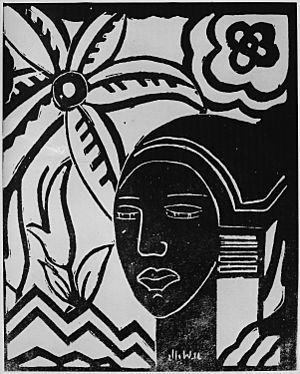James Lesesne Wells facts for kids
Quick facts for kids
James Lesesne Wells
|
|
|---|---|
| Born | November 2, 1902 |
| Died | January 20, 1993 (aged 90) |
| Nationality | American |
| Education | Lincoln University in Pennsylvania Columbia University National Academy of Design |
| Occupation | Graphic artist, Teacher |
| Known for | Printmaking, Painting |
|
Notable work
|
American Fantasy (1929) |
James Lesesne Wells (born November 2, 1902 – died January 20, 1993) was an important African-American artist. He was known for his graphic art and paintings. Wells was part of the exciting Harlem Renaissance art movement. He also taught art at Howard University for many years. Many people see him as a leader in modern art teaching.
Contents
Wells's Early Life and Schooling
James Lesesne Wells was born in Atlanta, Georgia on November 2, 1902. His father was a minister and his mother was a teacher. When James was young, his family moved to Florida.
His first art experience was helping his mom with her kindergarten art class. When he was 13, James won two art prizes at the Florida State Fair. He won first prize for painting and second prize for woodworking.
Wells went to Lincoln University in Pennsylvania. Later, he studied art at Columbia University in New York City. He also learned more about art at the National Academy of Design.
Wells's Art Career
Becoming a Graphic Artist
Early in his career, Wells mostly worked as a graphic artist. This means he created pictures for books and other publications. He used methods like block printing, lithography, and etching. These are ways to make many copies of an artwork.
He made pictures for poetry books and history magazines. In 1929, Wells started teaching at Howard University in Washington D.C.. He taught crafts like block printing and clay modeling.
Two years later, Wells helped Howard University offer classes in linoleum printmaking. He was known for his new and creative printmaking styles. He was also a great teacher and helped many young artists. Some of his students became famous, like sculptor Elizabeth Catlett.
Wells as a Painter
After 1931, Wells became known for his paintings too. Many of his paintings were shown at the Phillips Memorial Gallery in Washington D.C. His art was also part of traveling shows and displayed in museums worldwide.
Wells's early art was inspired by German Expressionist woodcut artists. He also liked abstract cubism and African sculpture. During the Great Depression, Wells led a summer art program in Harlem. Famous artists like Jacob Lawrence were his assistants.
In the early 1930s, the Great Depression made Wells think about his art. He decided to create art that was more affordable for people. So, he focused on making art that could be copied. This included lithographs, woodcuts, and etchings. His new art showed the experiences of African-Americans. It often featured workers from different backgrounds.
After World War II, Wells worked in a famous art studio in New York City. In the 1950s, he kept teaching at Howard University. He also continued to create and show his artwork. Wells was active in the civil rights movement in the 1960s. He protested for equal rights and fair hiring practices.
Wells was an important artist in Washington D.C. for 60 years. He stopped teaching in 1968 but kept making art into his eighties. In 1973, Fisk University held a special show just for his work. In 1980, President Jimmy Carter gave Wells an award. It was for his lifelong contributions to American art. In 1986, a big show of his art called "Sixty Years in Art" was held.
James Lesesne Wells passed away in Washington D.C. on January 20, 1993.
Awards and Honors
- Harmon Foundation, Gold Medal, Flight into Egypt, 1931
- Smithsonian Institution, First Prize, Religious Art Exhibition, 1958
- Presidential Citation for Lifelong Contribution to American art, 1980
Images for kids



